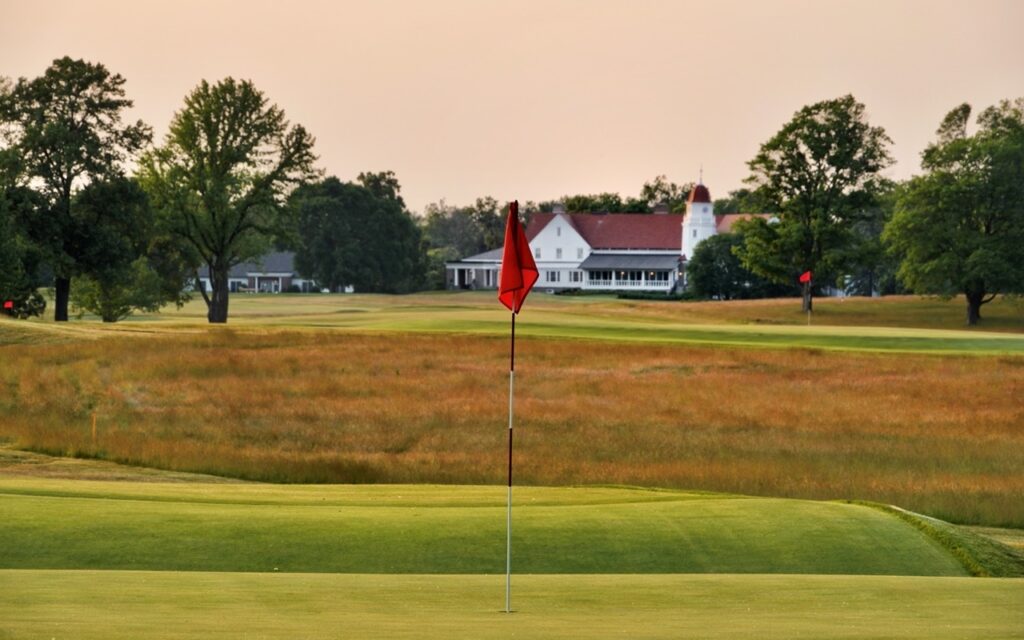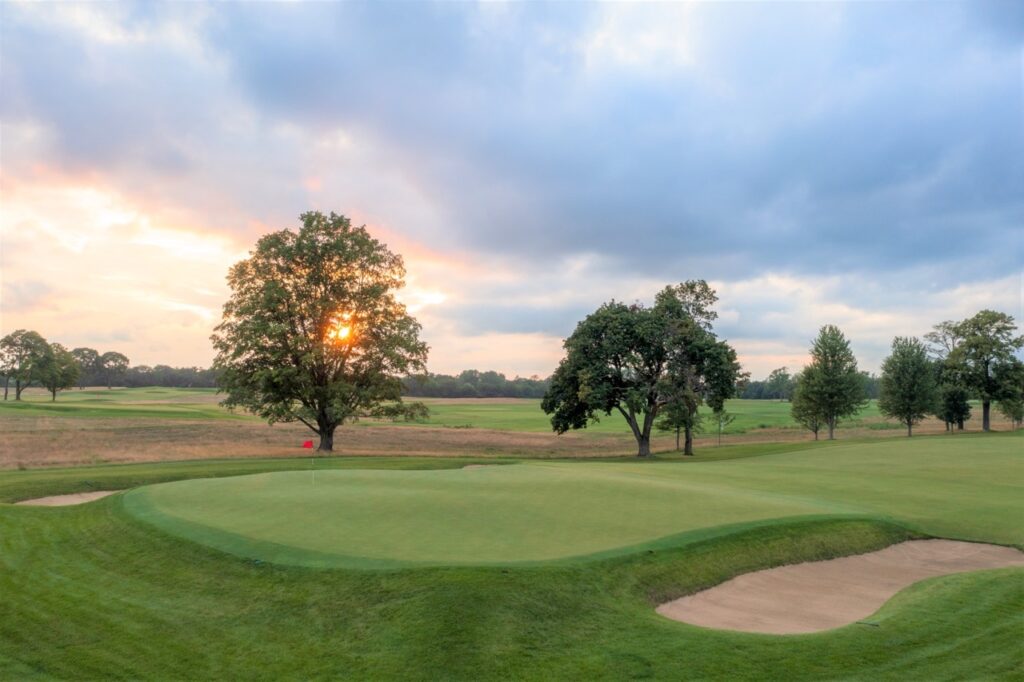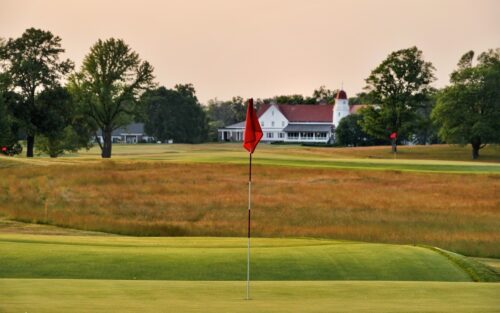
By David A. F. Sweet
There are few more venerable names among golf architects and engineers than Seth Raynor. Primarily based on the East Coast, where he was involved with the creation of courses at the Piping Rock Club in Locust Valley and the Everglades Club in Palm Beach, he also designed Shoreacres in Lake Bluff – a Golf Digest top 100 fixture.

This shot from the thirds green adorns the cover of The Prairie Raynor. Photo by Jon Cavalier.
Yet the protégé of Charles Blair Macdonald might be best known in the Chicago area for a course whose formation he had nothing to do with, yet one his mentor had everything to do with – Chicago Golf Club. And now the full impact of his redesigned gem that opened a century ago is explored in the pages of a new book. Written by Chicago Golf historian John Moran along with United States Golf Association (USGA) historian Rand Jerris and published by Grant Books in England, The Prairie Raynor fills more than 300 pages with exquisite photos and superb research. It reminds one of the top-notch coffee-table books the late Anthony Edgeworth used to put out, including Legendary Golf Clubs of the Midwest that profiled a number of area courses.
The Chicago Golf Club’s pedigree is hard to match. It was one of the five founding clubs of the USGA in 1894 and the only one not based on the East Coast. It has hosted three U.S. Opens and a dozen USGA championships overall.

Though Seth Raynor designed and constructed some of the nation’s most memorable golf courses, he rarely played the game. Photo by Mary Cummings.
The authors explain that only 20 or so years after the Wheaton course designed by Macdonald opened (the original Chicago Golf Club in Belmont was the first 18-hole tract in the land), changes were desperately needed. Weeds marred the greens, along with bare spots. Golf Illustrated noted, “The old course, as the site of championship events, was doomed.” World War I postponed any changes, and more than 150 members resigned, some opting instead to play Old Elm, Onwentsia or Shoreacres further north. The future of the club itself was grim.
With Macdonald’s blessing, Raynor rebuilt Chicago Golf starting in 1921. Raynor had never seen a prairie before, and at the outset he spent two days in the club’s clock tower admiring the expanse and gathering inspiration. When the full 18-hole layout opened on July 4,1923, no less an authority than Chick Evans called it “one of the best in the country,” according to Golf Illustrated.
Ironically, when Grant Books pitched the idea of a centennial celebration of Raynor’s masterpiece, Moran – who first walked the course as a 12-year-old caddy — was hesitant. He had just re-envisioned the club’s historical displays, the clubhouse was being restored, and a new irrigation system and bunker restoration were being implemented on the golf course.
“These projects were quite significant to our little club,” Moran said. “To take on another significant project that soon just wasn’t in my vision of reality.”
Once he was convinced that a compelling storyline existed so that it wouldn’t merely be a book of pictures, Moran contacted Jerris to ask for his involvement, which was crucial.
“Rand pointed out how our beautiful prairie course isn’t just a golf course, but rather that it’s an artistic and architectural work in the fullest sense of those terms,” Moran said. “Raynor had employed the same tools as artists and architects – line, massing, iconography, visual effects – to produce a course that so naturally fit its location.”
 The fifth, sixth and seventh holes at Chicago Golf are known as Leven, Double Plateau and Redan. Seth Raynor’s love of large, square greens is apparent on the left. Photo by Andy Johnson.
The fifth, sixth and seventh holes at Chicago Golf are known as Leven, Double Plateau and Redan. Seth Raynor’s love of large, square greens is apparent on the left. Photo by Andy Johnson.
A longtime student of golf-course architecture, Jerris found the wording to describe Raynor’s artistry to be the biggest challenge he faced.
“John and I invested great time and energy in finding new ways to talk about a golf course that emphasized its greatness as a work of landscape art, as much as it is a great playing surface,” said Jerris, who added that pinpointing the seminal moment of artistic creativity when Raynor sat in the clock tower was the favorite thing he learned during his research.
So is today’s Chicago Golf a Raynor course, a Macdonald course – or a combination of the two? It’s definitely a Raynor course, Moran said, though since Macdonald founded the club and was known to pontificate, “there’s no way Charlie could have helped himself from opining on what to do.”
Moran pointed out that Raynor left subtle reminders of the course’s history and its link to Macdonald.
“Some features were employed in the new design (e.g., certain mounds and bunkers), while others were left in areas adjacent to the line of play, acting as sentinels of an earlier time and as an homage to Macdonald,” he noted.

The sun begins to set over the 16th green. Photo by Jerry Rossi.
Not even three years after Chicago Golf’s rebirth, Raynor died suddenly of pneumonia at age 51 after he had been hired to design Cypress Point and before he could finish the Everglades. Somewhat ironically, he really didn’t play golf, saying that if he had, the courses he created would have been too easy. Wrote Macdonald in Scotland’s Gift – Golf, “He scarcely knew a golf ball from a tennis ball when we first met.”
All the more amazing that he had the perfect eye for creating holes golf aficionados love.
The Sporting Life columnist David A. F. Sweet can be reached at dafsweet@aol.com.






